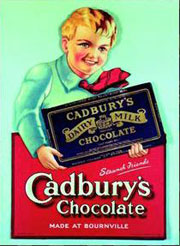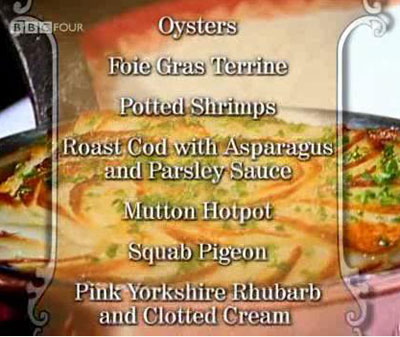The Edwardians and their food on BBC Four
 BBC Four is running a series of program(me)s about the Edwardians, and two of those are about the food of the era. They have already aired but will be repeated several times as most BBC Four shows are. Both are well worth watching for anyone interested in food and history.
BBC Four is running a series of program(me)s about the Edwardians, and two of those are about the food of the era. They have already aired but will be repeated several times as most BBC Four shows are. Both are well worth watching for anyone interested in food and history.
Edwardian Supersize Me is the showier of the two. Giles Coren, food critic for The Times, and TV presenter Sue Perkins lived the life of well-off Edwardians for a week, and ate like the Edwardians of the upper-middle class did - in Sue's case while wearing a corset. Their in-house meals were cooked by famed food writer Sophie Grigson, from an Edwardian housekeeping book, and they also ate out frequently since this was the era when restaurant dining became popular in England.
Their meals were something like this:
Breakfast: Meat Meat Meat Eggs Fish Meat Offal Meat - oops time for Lunch! More Meat Meat Fish or Shellfish Cream-or cheese-sauced carb dish Meat Meat Dessert - oops time for Tea! Cake Cake Cake Scones Bread Cake Sugar Cake Cake - oops time for Dinner! Meat Meat Meat Some Jellified Thing Cheese... you get the idea. Here's a menu for lunch, which doesn't show the last course (Friandises):

The amounts eaten were amazing, and all that... MEAT was just really mind boggling. Watching Giles and Sue gorge, suffer, then finally turn almost feral from all the MEAT, was amusing. The frequent belching, farting and occasional throwing up was... well ok, let's forget that part. All in all a fun and pictoresque hour of entertainment. (Giles Coren has written about his experience. )
As entertaining as Edwardian Supersize Me was, I enjoyed The Edwardian Larder even more. It was a more scholary documentary that featured some well known British food brands that had their start in the Edwardian period - Typhoo Tea, Perrier, Cadbury's Milk Chocolate, Marmite and (briefly) Oxo. Unlike the superficial take on similar themes on shows like Unwrapped in the U.S., this showed just how national and even international brands came to be so prevalent. For instance, Perrier, which was a company founded by an Englishman, managed to sell the idea that French mineral water was much superior. They put as much emphasis on the design of the bottle as with anything else. This was also the era when celebrity endorsements became a critical part of marketing - Scott's ill-fated expedition to the South Pole for instance was laden with free food from various companies eager to see their brand associated with such a heroic - and well-publicized - undertaking.
The Marmite segment was fascinating (of course I am somewhat obsessed by yeast spreads anyway). The company was actually started by a Swiss, which makes me wonder if Cenovis or Cenovis-like products existed before Marmite in Switzerland. (On a related note, it's interesting that two of the world's leading dessicated soup base companies are Swiss - Knorr and Maggi.) Marmite is a by-product of making beer, and was originally sold as a soup stock base. What's more, it was marketed to vegetarians as an alternative to beef tea, which was tremendously popular at the time for health reasons. (This explains why invalids in old novels are often fed things like beef tea and jellied veal. I've always wondered about that.) It was also mentioned (in the Supersize Me program) that the suffragette movement was associated with vegetarian restaurants. Marmite and Women's Rights, hand in hand - the mind boggles.
One statement that caught my attention was that national and international brands were able to gain popularity because their product was seen as being of higher quality, 'more pure', and more hygenic than foods prepared locally with no recognizable labels. People liked that the branded, sturdily packaged foods had been barely touched by unknown human hands. Ironically, a hundred years later the pendulum is swinging in the opposite direction; the craze now is for the small local production, the 'homemade', the minimally packaged. The Edwardian era was also when mass food exportation got into full swing - all that beef had to shipped from somewhere (mostly South America and the U.S.). Now everyone is earnestly talking about 'eating local'.
In any case, these are the type of shows I like to bring up to TV naysayers: when used well, the medium of television can delivery something truly enlightening.
Historic food adventures continued in The Supersizers Go
In 2008 the concept of Edwardian Supersize Me was continued, sending Giles and Sue to other historical eras to gorge themselves.
Supersizers Go recaps
- Edwardian Supersize Me, not part of the series, but sort of the pilot that aired in 2007
- Description of the whole series, plus World War II (episode 1)
- Restoration (episode 2)
- Victorian (episode 3)
- 1970s (episode 4)
- Elizabethan (episode 5)
- Regency (episode 6, last in series)
If you enjoyed this article, please consider becoming my patron via Patreon. ^_^

 Welcome to Just Hungry, where we serve authentic Japanese recipes and more! I'm
Welcome to Just Hungry, where we serve authentic Japanese recipes and more! I'm 














Comments
patrice mark
2 February, 2012 - 23:47
Permalink
Re: The Edwardians and their food on BBC Four
I recently viewed season 1 and season 11 of Downton Abbey, and I was curious as to the actual meals that were prepared (and consumed) by the gentry - and I was most surprised to read your account of the volume of food typically eaten. I wondered if in the miniseries, they purposely showed very small amounts of food each person would take for themselves, including the servants down in the kitchen, instead of showing the larger amounts you suggest.
Thank you for any information!
maki
3 February, 2012 - 05:53
Permalink
Re: The Edwardians and their food on BBC Four
For the upstairs people (the ones being served) I think it is very likely that, while meals consisted of multiple courses and lots of dishes, that many people just took a little bit of each and skipped dishes they didn't like. And if they didn't...I guess they ended up looking like Henry VIII or William Howard Taft! As for the downstairs people (the staff) they probably did eat more heartily, but also worked it off with long, hard hours of labor.
Remember also that Downton Abbey is a fictional show, and the focus is not on food, so when they are eating the food just incidental. If they showed people pigging out on their food, that would certainly be too distracting. (I just remembered though that Hugh Bonneville was on the Jonathan Ross Show (a UK talk show) and he said jokingly that for a certain breakfast scene, he loved the sausages so much that he somehow managed to make them go through 6 takes or something.)
Pamela Foster
18 March, 2012 - 02:41
Permalink
Re: The Edwardians and their food on BBC Four
Are the episodes available to buy or stream online? I blog about the food of Downton Abbey, and like all good cooks am always looking for new recipe ideas. Plus it is great fun to see documentaries where others have as much fun with history and food as I do.
maki
1 April, 2012 - 20:00
Permalink
Re: The Edwardians and their food on BBC Four
Unfortunately these programs haven't been issued on DVD, and are not streamed or available for download (legally). A shame really.